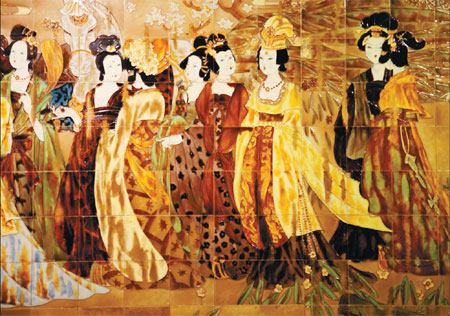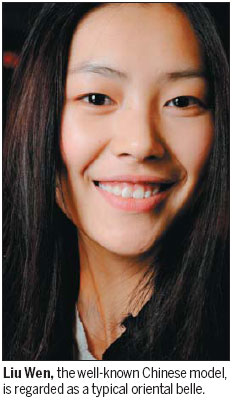
Ladies in Tang Dynasty on a fresco are portrayed with round pale faces, cherry-like mouths and plump figures. Provided to China Daily

Ideals of beauty have changed dramatically throughout Chinese history from thin and fragile to plump and healthy, with today's desire to look Western fueling a growing culture of plastic surgery
Today, the Chinese idea of female beauty has taken a strong swing toward Western standards, with many young women desperate for a higher bridged nose, eyelids or a sharper chin. It's a desire that has fueled a culture of plastic surgery among the wealthy.
But it hasn't always been so. In fact, the ideals of Chinese beauty in the past were far removed from modern ideas and have changed dramatically over time.
Before the Qin Dynasty (221-206 BC), women were expected to be feminine and delicate.
But by the time of the Han (206 BC-220 AD) and Southern and Northern dynasties (420-581 AD) this had changed, with morality regarded as of greater importance than physical appearance. During this period, women's clothes became simpler and it was common to use rice powder to cover facial blemishes.
By the Tang Dynasty (618-907 AD), a healthy plump look was considered beautiful. Yang Yuhuan, an imperial concubine of Emperor Xuanzong, was considered one of China's four great beauties and admired across the country for her looks. She was a plump woman with a round pale face and flushed cheeks, a cherry-colored mouth and an arched brow.
According to Liu Yidong, an expert in Chinese classical physiognomy, from Tang Dynasty paintings we can see that a wide forehead, round face and portly figure were considered indispensable characteristics of beauty. A healthy look too was considered an important trait.
In the Song Dynasty (960-1279 AD), the ideal of beauty was turned on its head as an unhealthy look became popular. During this time women wanted thin shoulders, a slender waist, a flat chest, a pale face and small feet. Women often bound their feet to achieve this final trait.
By the 1930s, ideas had changed again. The Shanghai actress Hu Die epitomized beauty at this time. She had chubby cheeks with dimples, arched eyebrows, an ample bosom and full hips.
While previously women wore makeup to achieve the ideal of beauty of their time, today an increasing number of Chinese women are going under the knife.
Plastic surgery has become a part of the beauty culture of wealthy Chinese women, with the country ranking third behind the US and Brazil for cosmetic surgery, according to a New York Times report.
Much of the plastic surgery is aimed at making women look more Western, with nose surgery, facelifts and double-eyelid construction the most common procedures, according to Li Bin, a plastic surgeon at the Chinese Academy of Medical Sciences.
"Many girls have narrow eyes with single eyelids and the double-eyelid procedure can make their eyes bigger, although it's not suitable for everyone," Li says.
That classic round-faced beauty of the past is now out of fashion with sharper chins considered more attractive today and this has given rise to a high number of bone shaving operations.
"You can see that all the operations are about changing to become more Western," says Li.
"Other popular plastic surgery procedures include botox injections to remove double chins and chubby cheeks, and whitening injections to make the skin more pale, because in China lighter skin is generally regarded as more desirable than darker skin."
There has been some backlash against these harsh moder ideas of beauty and the rise in cosmetic surgery that has come with them.
Some Chinese models have bucked the trend, according to American photographer Jason Clarke, including Emma Pei, Liu Wen and Du Juan.
"They are natural, fresh and have elongated eyes. This is the type of face I have seen in ancient Chinese paintings. They represent a typical oriental belle," he says.
"Most importantly, these models are not going under the knife and they exude an air of confidence."
yinyin@chinadaily.com.cn
